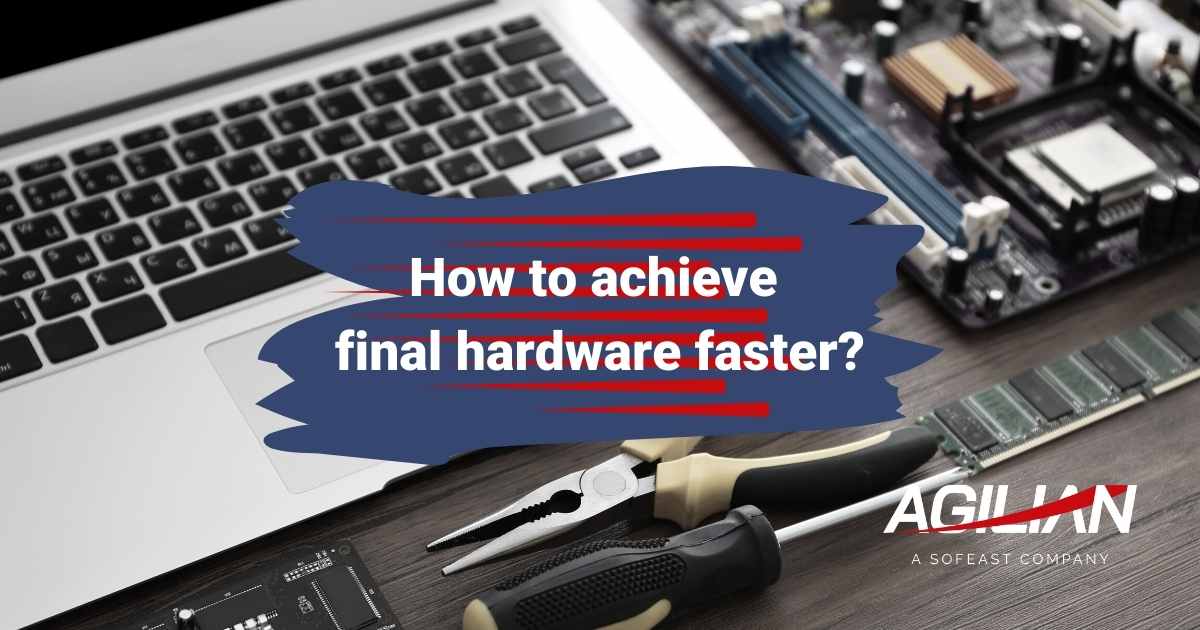
What is final hardware?
Final hardware really means a combination of software and physical hardware (in the case of many electronics). Hardware commonly includes materials, metals and electronics, PCBs, the design aspects of the product, etc. ‘Final’ hardware is a combination of both because if you have the hardware ready, but the software isn’t, then the product is not ready to ship. In order to start mass producing a product you need to have everything ready and this is why it’s important to understand how can we shorten the product hardware’s overall life cycle by focusing on individual design aspects and individual tasks as opposed to schedules only.
Why is it important to speed up getting to market?
First of all, if you have a well-designed product with all these elements perfectly fitting together you’re going to have a shorter time to market which means you’re going to save a lot of money. Hopefully, you will also have a lower return rate which also reduces costs. So cost savings are certainly the biggest incentive, but there are other incentives, too.
For example, if you’ve got a brand new technology this will be the way to go. With innovative ideas, getting to market first and winning that early market share is really important from a marketing point of view.
How to get to final hardware faster?
I’ve written about how the product life cycle in the development phase works and talked about EVT, DVT, PVT and the milestones that relate to these that you have to make sure your product actually passes through in order to manufacture a quality, safe, and reliable product. That’s an over-arching plan.
In the case of the product development life cycle, we’re talking about mostly scheduling programming and basically trying to make sure that we can cut the corners on the timeline as safely as possible and see how we can get to a complete product faster.
However, when we’re talking about how to shorten the time to final hardware, that has to do a lot with specific design tasks that you have to do to speed up the process. This cannot really be achieved unless individual tasks done by each of the involved departments can actually shorten their project timeline, too. For example, the hardware, software, quality, and reliability teams need to have very good standardized procedures and follow a meticulous timeline so they know exactly how they can schedule them within each new product introduction milestone. Once they’re in this position, they can actually cut down on time wasted and as a result, end up having a shorter product development life cycle which will, in turn, end up actually helping all the projects achieve a quicker turnaround.
How does each department help get the whole product ready so that we can go ahead and manufacture it as soon as possible? Here’s a short breakdown of what each department should do to move the process along swiftly:
All departments to work in sync to achieve final hardware
First, you need to make sure every department like R&D, any department for hardware and software, purchasing, quality, reliability, and manufacturing departments works beautifully together. They need to be well-organized with everyone knowing exactly what needs to be done to get there faster.
Design FMEA early on
For example, in the case of hardware, it’s crucial to have a design FMEA which is a risk analysis technique done on the design. If you don’t de-risk your product design and later you find a problem due to them, it’s going to be pretty hard to go back and fix those issues retrospectively once a product has been manufactured compared to when it’s still on the drawing board. So it’s critical to have a team that is going to do DFMEA (design failure mode and effect analysis) right at the beginning as early as possible.
Test prototypes and components test to failure
The next thing to do is to test to failure. The tests can be related to the design, components, PCBs, etc. Focusing on PCBs, for example, you could do HALT, drop, vibration, shock, high and low voltage and current, and high and low temperature testing until failure. When you’re testing your product you are finding issues and actually improving its specification. You also find out how far you have to come down from that failure point so you have your operational limits for the product before it fails which will also be included in the specifications.
Specify your tolerances
Don’t forget to specify your tolerances, which are either tight or open/flexible depending on the application of the component, in your specifications, too.
Implement ‘Design for Excellence’
DFX (design for excellence) takes place when you’re designing a product, especially early on, and it spurs you to think of all kinds of ideas about how to improve your product design because you’re purposefully optimizing it for certain goals. For example, using fewer components leads to less waste, less testing required, and a more reliable product; in turn reducing your costs. But your goal may be totally different: higher quality, more durability, recyclable products…you can optimize your product design for whatever is most important to you.
Bug tracking & reliability testing during software development
Bug tracking, or issue tracking as it’s sometimes known, is done to help you know exactly which bugs have been fixed and which are still open issues awaiting a fix. Put someone in charge of approving that the bugs have been fixed and validated. If you don’t have a good way of tracking that bugs have been fixed and tested, rather than an engineer just noting that it’s ‘done’ without testing it, you’ll get into all kinds of trouble.
Reliability engineering on the software side is also a critical task. You need to do a live software test to see how far it can run before it actually crashes.
UX testing
When the software is almost finished a final step is user experience testing. Often during the engineering and development phase, no matter how well the teams design products and software, unforeseen things happen. At this point, take some of the products and hand them over to average users and then let them give you feedback on what they would like to use, positive points, drawbacks, and any other notes. The feedback on UX can help the team make changes where required.
Purchasing support by sourcing components that reach everyone’s requirements
Purchasing is probably the most important support team for designers. Without them, the design team can’t actually develop the product because they need purchasing to provide an approved vendor list (these are suppliers that have already been audited and have the capacity to be able to develop these products in the volumes required, and the prices and specifications that are agreed).
Sourcing tasks like this are very time-consuming and detailed and purchasing has to coordinate with the various teams: design, quality, reliability, software, etc, and actually go and audit suppliers to come up with components that meet and exceed all of their respective requirements, not only those of design, but also reliability and product life and durability requirements, too, for example.
Quality is well-prepared
The quality team can contribute to shortening the time to final hardware by creating inspection documentation as well as preparing and purchasing the inspection tools and training the inspectors. They should also make sure that there are clear IQC procedures (incoming quality control) and OQC (outgoing quality control). During production, there should be a control plan and all sorts of procedures to make sure that the product is going to go out the door meeting all the quality, reliability, design specification and performance requirements
One other thing that is very important for product quality is making sure that the product and company meet ISO requirements and that the quality management system (QMS) is all up to date in terms of documentation and that QC inspectors are well-trained.
Reliability testing
Reliability is one of the most important themes within the product development life cycle. If you want your hardware to be able to meet and exceed quality and reliability requirements and make sure that it’s going to achieve reliability goals, then you must have a reliability team that is knowledgeable and creates test cases and test plans that meet or exceed reliability goals.
There is another concept called DFR (Design for Reliability) which is very important to apply to your product design early on. By doing so, you’re actually designing products with reliability in mind and making sure that they can withstand likely challenges. For example, if you’re designing some kind of mobile phone you will no doubt determine that consumers will drop the product by accident. While optimizing for DFR, you might therefore consider protecting the display from drops by adding a slightly larger bezel around it.
An optimal reliability test plan is also critical to making sure that all possible worst-case user scenarios are tested for and this will in turn help lower the returns and their associated costs.
Manufacturing optimization
There are plenty of tasks that can be done during manufacturing, such as line balancing, where we make sure that one assembly operator is not overloaded while another is underutilized. At the same time, apply mistake-proofing techniques to ensure that there are fewer chances of having failures on that line that could affect product quality and reliability, such as automation, implementing jigs, and test procedures with very precise test equipment.
Conclusion
In conclusion, there is a difference between shortening the product development life cycle which mainly talks about scheduling program management and how to shorten development time, for example, by reducing the number of builds per cycle, and getting to the final hardware quickly. For the latter, every individual department within your organization must do their due diligence on applying all sorts of best-in-class techniques during product development in order to not only shorten the time to final hardware along with software at the same time but also to save time and money, too.
As ever, if you’re trying to bring a new product to market right now and you have questions about this or other related topics, reach out to us. We’ll be happy to help!
The Author
Our head of New Product Development, Andrew Amirnovin, is an electrical and electronics engineer and is an ASQ-Certified Reliability Engineer.

He is our customers’ go-to resource when it comes to building reliability into the products we help develop. Before joining us he honed his craft over the decades at some of the world’s largest electronics companies such as Nokia, AT&T, LG, and GoPro.
At Agilian, he leads the New Product Development team, works closely with customers, and helps structure our processes.



